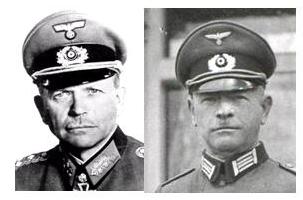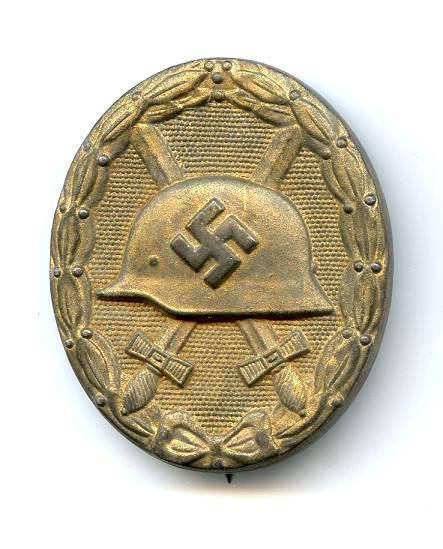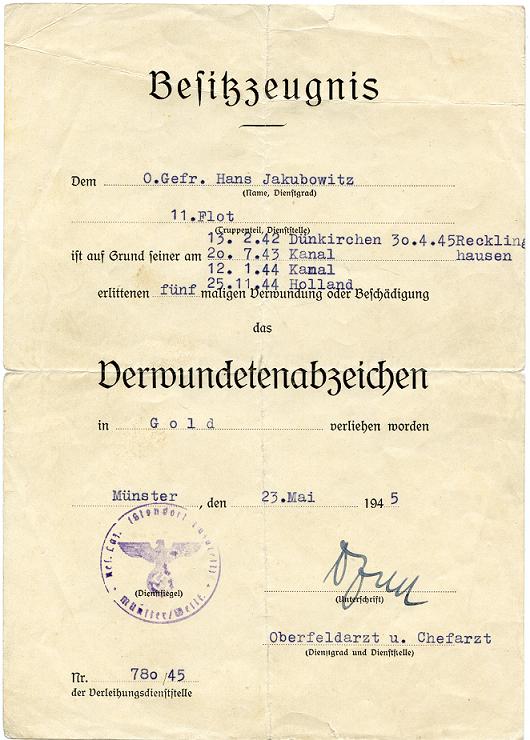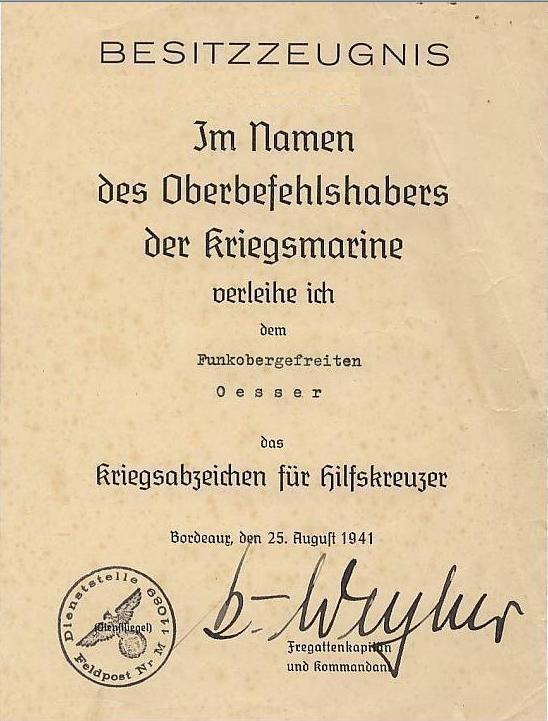-
Posts
5,391 -
Joined
-
Last visited
-
Days Won
3
Content Type
Profiles
Forums
Blogs
Gallery
Events
Store
Posts posted by Gordon Williamson
-
-
But this one is a rather elderly Police Officer transferred into the Military Police. A mere ( considering his age and host of medals) Leutnant der Feldgendarmerie.
 0
0 -
Rather like old Heinz isn't he ?
 0
0 -
Absolutely nothing wrong with this one IMO. I'd be happy to own it.
Not necessarily a Mayer variant. Could well be Schickle as wide pin variants of the Schickle badge exist as well as the usual needle pin version.
Lovely badge.
0 -
Thanks guys! Out of interest, this fellow served with 11 Vorpostenflotille. This Flotilla was equipped with refurbished fishing boats and used in the English Channel and North Sea. Only very lightly armed ( see photo for a sample of such boats) they were often attacked by RAF aircraft and were not exactly capable of putting up much of a fight against aircraft. I suspect this guys first few wounds were sustained during strafing attacks by British aircraft.
 0
0 -
And the badge that came with it.
Nice to see so much gilt finish still intact on a late war Zinker.

 0
0 -
I could count on the fingers of just one hand the number of Kriegsmarine Gold Wound Badge Docs I have had. Infinitely rarer than those for the Ground forces.
This one is particularly interesting in that all his previous wounds are listed so we can see not only when, but where he was wounded. Goodness knows what he was doing so far inland to be wounded at Recklinghausen just before the end of the war. Interesting also that although the Doc was issued to him just after the war ended, still in hospital, the stamp still has the swastika intact.
 0
0 -
Nice to see relics like this directly linked to KM units in Narvik ! It makes something rather common suddenly become very interesting !
0 -
The very rough finish on the reverse and what looks like casting seams on the edges suggest that this may well be a casting taken from a 1957 version.
 0
0 -
Definitely an original period piece, and an early example with the round wire retaining clip. No problems here.
(Glad you enjoyed the book )
0 -
Hi Gentry
Didn't think for a moment you were having a go at Pete. To be honest, although the tunic is a nice original piece, my own opinion is that either the sleeve stars or the shoulder straps have probably been added postwar. The mix of line sleeve stars and medical boards just doesn't fit.
If I bought this one, I'd either remove the Aesculapian staff from the shoulder straps or add replace the sleeve starts with a pair of these -----
 0
0 -
A true medical officer candidate tunic would have the Aesculapian staff, not the five pointed line star.
To be fair, Pete has noted this in his description of the tunic.
0 -
Well the ribbon and insignia look fine. The cap itself doesn't have any obvious flaws from these pics, but private purchase types are always harder to tell, and for that reason with the Matrosenmütze I only ever buy official regulation issue types where there are set, standard features to go by. Blue lining is great in a Visor cap, but ss soon as I see it in a Matrosenmütze or Bordmütze, I walk away.
I'm sure blue lining was used from time to time on this type of headgear during the period,but its a bit like dealing with "variants" in badges, there is always a small level of doubt when dealing with private purchase KM headgear. Period KM headgear is rarely maker marked ( apart from private purchase) but postwar BM headgear is nearly always maker marked and vast quantities of early postwar BM headgear have been "converted".
Having said all that, your cap may well be 100% wartime. In its favour is the location of the maker. Bochum, in the Ruhr, isn't a sea port and most of the makers I have seen in BM headgear have been in the big sea ports, like Kiel, Hamburg, Wilhelmshaven etc.
What is the material used for the cap band stiffener? Postwar are virtually always pasteboard, whilst official wartime pieces are always celluloid. I've never seen a postwar one with a celluloid band stiffener.
0 -
Superb cap Ben.
As to the owner, I only have the 1944 rank list but it includes only one officer with the name of Heyne.
He is Oskar Heyne, Oberleutnant zur See, so I think that if there is no other Karl Heyne then your cap most likely is from the L.I. on U-557.
Congratulations on a beautiful cap.
0 -
I don't believe that the specific type of screw fitting will identify the maker, however the fakes made by Floch often feature this type of large "clamshell" fitting. Clearer scans would be needed to get a better impression of the possibility of this one being a good one, the images here are too small and too dark to see fine details clearly.
0 -
Nicely displayed. Your First pattern E-Boat is a real stunner and would be the centrepiece of any KM collecton.
0 -
Yet another EBay mis-identified photo. Once again sold as Feldgendarmerie but this guy is from a much , much rarer unit, the Zugwache.
 0
0 -
Bought this because I haven't come across too many shots of Feldgendarmen from the late part of the war wearing the M43 cap.
But dontcha just love these women with a taste for elegant footwear. Fut coat and --------cleated mountain boots !
 0
0 -
Super set Martin ! Aux Cruiser doc is identical format to the one I have.
 0
0 -
Congratulations Martin, a rare document indeed. Its interesting that the example I have appearing in the book was dated just a week or so earlier, signed by the same officer, but has the same serial number at top left. (342/43). I had assumed that this was a unique serial referring to that actual bestowal, but it can't be if there were two the same. I guess it must refer to a file number covering all the awards to the Kormoran crew.
It would also be interesting to know what the letter annotation at bottom left referse to. Yours is "J". The one I have from Kay is "Ni".
0 -
Looks like a nice set. There are several DK winners who are not acknowledged in any of the books so-far published. The fact that he can be seen to be wearing the miniature 57er DK on his ribbon bar and the entry for the award is in his Bundeswehr Wehrpass suggests that he was officially accepted as being entitled to the award.
I can only guess that some documentation was found which supported the fact that the award was granted.
0 -
Walle,
Your link only seems to go to the home page for Militaria 321, not to this specific lot. Need to know the item number or at least the key word for a search.
0 -
Hi Rob,
Its still a "work in progress". Two major hold ups.
First trying to track down good images of genuine Grand Crosses.
The second issue is technical. In the "old days" contributors would send photos of pieces they had for inclusion in the book. Today of course, you normally get JPEG images by email. These JPEGs look great on screen when you view them on your PC. Unfortunately, the demands of the new high tech digital printing processes need very high resolution images where digital shots are concerned. Most of the hundreds of images I have stored are JPEG.
If you open up a JPEG on screen alongside a TIFF image, both will look great. The TIFF image however will probably be around 2 or 3 Megabytes compared with a hundred or so KB for a JPEG. The TIFF will provide a nice quality image when printed in a book, but the JPEG will produce an image with lots of digital artefacting unless printed in very small size.
The problem now is that many of the examples I have images of in JPEG are no longer around (especially where the images were contributed by a dealer who has long since sold the piece.) so it is likely to be a long time consuming business to replace all the JPEG images with TIFF images.
Haven't given up on it though, but it'll take a while.
0 -
What you are seeing are actually just holes. The space between the inner pressure hull and the outer casing is free-flooding. As the boat dives, water pours in through these holes and floods this area between the pressure hull and outer casing. When the boat surfaces, the water simply pours out of these holes again. If you search around for some images of submarines surfacing, you should be able to see the water pouring out of these vent holes.
The exact configuration of these holes can vary from type to type and even from manufacturer to manufacturer. Some of the more technicaly oriented German references actually give details of the various configurations used by each maker, though from memory I think this was just for the Type VIIs. Can'#t recall seeing this info for the Type IIs.
0 -
In that case I'd suspect it has to do with the angle of the photo, light conditions etc. The step in the forward face isn't that pronounced. From the side, it would be clearer, but on a bow-on shot it could be very deceptive. Most likely those in your photo are Type IIb, the type for which the greatest numbers were built.
0




Guderian Lookalike
in Germany: Third Reich: Research, Documentation & Photographs
Posted
Hoping that Rick can ID his rack of predominantly WW1 awards. No 2 looks like East Front Medal and I can see the Police Long Service Award. Though No 1 was EK, but he has the EK ribbon in the buttonhole with the Spange.